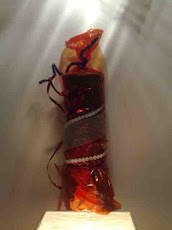



This was mainly by accident, but it works!
I had just read an article about the price of bread, which is going up non-stop as the price of grain increases, and one part of the article stated that "you still cannot make bread cheaper than you can buy it". This sounded like a challenge and so I thought, as my ever tolerant wife was out at a meeting, that I would show they were wrong. Looking at he way bread was made, with injections of steam etc I thought this would be no problem, a little ingenuity would suffice. However as I got into the baking process, I remembered that 1. I was supposed to get some shopping and 2. when Pam returned the kitchen would still be upside down, so I rushed through the process thinking that the birds would at least approve (again) of my failed efforts. But far from fail it all worked, so here is the receipe and the pictures to confirm it all.
Take one and a half mugs of warm water, pour them into a bowl and mix in one half a teaspoon of fresh dry yeast (yes I know its a lot) and a few pinches of salt. Pour in three mugs of plain flour and mix the whole lot together, (forget all that kneeding business) cover with cling film (I know I should have used a cloth, but I like to observe what is going on) and leave somewhere warm for an hour and a half (yes, I know its not long.) By then the whole mass, which has the consistency of the slime in Ghost Busters, will be covered in bubbles.
Give the whole lot a very quick stir and leave for a few minutes (possibly thinking 'this is never going to work') while you heat up the oven to around 220c/425f and as you do this put in the oven whatever container you are going to use to bake the bread in.
When the oven is at working temperature pour the dough into the now greased container, (but be careful, its hot, I 'found' out the hard way) cover it up with aluminum foil or whatever and put it in the oven for half an hour. My thought was that this would keep the moisture in for the first stage of cooking, After the thirty minutes take the cover off and leave it in the oven for ten more minutes to allow the top to brown.
Take out and allow to cool... yes...it really was that easy!
The top photo shows the dish and 'cover' before I put it in the oven, the next after half an hour and the next after ten minutes with the cover off. The result can be seen in the bottom photo. I must point out that our oven is rather old and about as reliable as a high mileage Trabant so you may have to experiment with the temperatures. Quantity wise, three of any sort of container should work for the flour/water ratios.
PS. It tastes as good as it looks!!




































